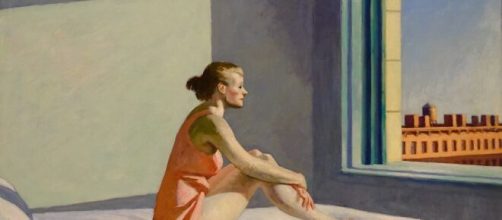When an artist’s work goes viral on social media, scoring hundreds of thousands of “likes,” it’s a call for celebration. Or is it?
Sign of the times?
Public response exploded when a Twitter user shared his view that “We are all Edward Hopper paintings now.” The tweet came with four of the artist’s iconic images of isolation and loneliness.
The tweet prompted The Guardian art critic Jonathan Jones to wonder if Hopper is “the artist of the coronavirus age.” No, says Art News associate editor Alex Greenberg: “We are not Edward Hopper paintings now. If only we were so lucky.” I'm with him on that.
Greenberg points out that while Hopper’s figures stare at nothing in particular and look lost, it’s a momentary thing. He quotes the artist saying that his figures are simply caught in a moment of “moving on.”
Continuing his thought, Greenberg contends that there’s no reason to doubt that when the female figure in "Morning Sun," for example, stares out her window, she’ll eventually get up and go about her day. And that’s not an option for “socially distanced” people during the pandemic.
We are the world
Also, while Hopper pictures loneliness, there’s often sunlight, too, as if to offer a hopeful sign. Says Greenberg. He gets that sign from the painter’s own words: “There is a sort of elation about sunlight on the upper part of a house.”
But Jones couldn’t disagree more.
He argues that Hopper’s paintings speak of the alienation of modern life: “The pandemic has given his work a terrifying new significance.”
To make his argument, Jones noted that not all paintings of aloneness speak of loneliness. For example, the lone figure in Caspar David Friedrich’s painting The Wanderer Above the Sea of Fog looks happy to have the moment to himself.
While Jones thinks that Hopper’s pictures are about aloneness, I’ll take them over some of the stuff offered up as art these days.
I'm thinking of the fly on a swirl of cherry-topped whipped cream intended for a pedestal in London’s Trafalgar Square, which just got short-listed for a Turner Prize.
How odd that the award is named after the British landscape painter JMW Turner, who specialized in capturing atmosphere on land and sea.
Not that Turner’s pictures didn’t also raise eyebrows. The Royal Academy disparaged them as blots owing to his loose brushwork.
The End
Heather Phillipson, whose work was short-listed, titled the fly on the swirl of whipped cream The End, to infer both cheerfulness and disquiet. But while Trafalgar Square is a place for both protest and celebration. The End conveys neither of those.
In fact, I thought “the end” came to the Turner Prize in 1995 when Damien Hirst won first place for his cold and heartless cow and calf bisected and suspended in formaldehyde that he called Mother and Child.
As I say, give me a Hopper painting of loneliness. At least it’s not soulless.


